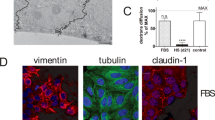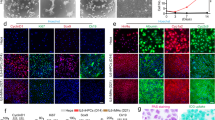Summary
To establish parenchymal hepatocyte cell lines, we tried to subculture the primary hepatocytes isolated from adult rats. The hepatocytes were cultured in serum-free modified Dulbecco’s modified Eagle’s medium supplemented with 10 mM nicotinamide and 10 ng/ml epidermal growth factor. When 6×105 cells were plated on 35-mm dishes coated with rat tail collagen, the cells proliferated and reached confluence at Day 6 to Day 8. The first subculture was carried out at Day 8 using 0.005% collagenase and gentle pipettings. Most cells were recovered and plated on the new dishes coated with the collagen (first passage). The attached cells could proliferate and reached near confluence when the cells occupied more than two-thirds of the dish surface. About a week after the first subculture, the second one was conducted. Although the number of the recovered cells was smaller than at the first passage, the cells could attach and proliferate to a certain extent. Thereafter, they were maintained for more than 2 mo. but they never overgrew. Albumin secretion into the culture medium was confirmed in the subcultured cells. Ultrastructurally, these subcultured cells possessed hepatic characteristics such as peroxisomes with a crystalline nucleoid and bile-canaliculus structures. When 10% fetal bovine serum and ascorbic acid 2-phosphate were added to the cells of the second passage, they began to proliferate very slowly. These proliferating cells were mainly mononucleate and had a small cytoplasm. In addition, some of them could differentiate into typical mature hepatocytes by forming a three-dimensional structure interacting with nonparenchymal cells. In this experiment, we showed the successful subculturing of parenchymal hepatocytes isolated from adult rats and provided evidence that the subcultured cells still have the potential to proliferate and to differentiate.
Similar content being viewed by others
References
Arenson, D. M.; Friedman, S. L.; Bissell, D. M. Formation of extracellular matrix in normal rat liver: lipocytes as a major source of proteoglycan. Gastroenterology 95:441–447; 1988.
Bissell, D. M.; Aenson, D. M.; Maher, J. J., et al. Support of cultured hepatocytes by a laminin-rich gel: evidence for a functionally significant subendothelial matrix in normal rat liver. J. Clin. Invest. 79:801–812; 1987.
De Leeuw, A. M.; McCarthy, S. P.; Geerts, A., et al. Purified rat liver fat-storing cells in culture divide and contain collagen. Hepatology 4:392–403; 1984.
Furukawa, K.; Mochizuki, Y.; Sawada, N. Properties of peroxisomes and their induction by clobibrate in normal adult rat hepatocytes in primary culture. In Vitro Cell. Dev. Biol. 20:573–584; 1984.
Furukawa, K.; Shimada, T.; England, P., et al. Enrichment and characterization of clonogenic epithelial cells from adult rat liver and initiation of epithelial cell strains. In Vitro Cell. Dev. Biol. 23:339–348; 1987.
Grisham, J. W. Cell types in long-term propagable cultures of rat liver. Ann. NY Acad. Sci. 349:128–137; 1980.
Guguen-Guillozo, C.; Clement, B.; Baffet, G., et al. Maintenance and reversibility of active albumin secretion by adult rat hepatocytes co-cultured with another liver epithelial cell type. Exp. Cell Res. 143:47–54; 1983.
Harlow, E.; Lane, D. Immunoassays. In: Harlow, E.; Lane, D., eds. Antibodies: a laboratory manual. NY: Cold Spring Harbor Laboratory; 1988: 555–599.
Hata, R.; Senoo, H. L-Ascorbic acid 2-phosphate stimulates collagen accumulation, cell proliferation, and formation of a three-dimensional tissuelike substance by skin fibroblasts. J. Cell. Physiol. 138:8–16; 1989.
Houck, K. A.; Michalopoulos, G. K.; Strom, S. C. Introduction of a Ha-ras oncogene into rat liver epithelial cells and parenchymal hepatocytes confers resistance to the growth inhibitory effects of TGF-β. Oncogene 4:19–25; 1989.
Immenschuh, S.; Petzinger, E.; Katz, N. Secretion of plasma proteins and its insulin-dependent regulation in rat hepatocyte-hepatoma hybrid cells. Eur. J. Cell Biol. 60:256–260; 1993.
Isom, H. C.; Strom, S. C. Role of viral and cellular oncogenes and growth factors in hepatocarcinogenesis in culture andin vivo. In: Sirica, A. E., ed. The role of cell types in hepatocarcinogenesis. Boca Raton, FL: CRC Press; 1992:265–298.
Kent, G.; Gay, S.; Inoue, T., et al. Vitamin A-containing lipocytes and formation of type III collagen in liver injury. Proc. Natl. Acad. Sci. USA 73:3719–3722; 1976.
Koide, N.; Shinji, T.; Tanabe, T., et al. continued high albumin production by multicellular spheroids of adult rat hepatocytes formed in the presence of liver-derived proteoglycan. Biochem. Biophys. Res. Commun. 161:385–391; 1989.
Kojima, T.; Mitaka, T.; Paul, D. L., et al. Reappearance and long-term maintenance of connexin 32 in proliferated adult rat hepatocytes: use of serum-free L-15 medium supplemented with EGF and DMSO. J. Cell Sci. 108:1347–1357; 1995.
Kreamer, B. L.; Staecker, J. L.; Sawada, N., et al. Use of a low-speed, isodensity Percoll centrifugation method to increase the viability of isolated rat hepatocyte preparations. In Vitro Cell. Dev. Biol. 22:201–211; 1986.
Michalopoulos, G. K.; Pitot, H. C. Primary cultures of parenchymal liver cells on collagen membranes: morphological and biological observations. Exp. Cell Res. 94:70–78; 1975.
Minato, Y.; Hasumura, Y.; Takeuchi, J. The role of fat-storing cells in Disse space fibrogenesis in alcoholic liver disease. Hepatology 3:559–566; 1983.
Mitaka, T.; Kojima, T.; Norioka, K., et al. TGF-β completely blocks the formation of small-cell colonies: effects of mito-inhibitory factors on the proliferation of primary cultured rat hepatocytes. Cell Struct. Funct. 20:167–176; 1995.
Mitaka, T.; Mikami, M.; Sattler, G. L., et al. Small cell colonies appear in the primary culture of adult rat hepatocytes in the presence of nicotinamide and epidermal growth factor. Hepatology 16:440–447; 1992.
Mitaka, T.; Norioka, K.; Mochizuki, Y. Redifferentiation of proliferated rat hepatocytes cultured in L-15 medium supplemented with EGF and DMSO. In Vitro Cell. Dev. Biol. 29A:714–722; 1993.
Mitaka, T.; Norioka, K.; Nakamura, T., et al. Effects of mitogens and co-mitogens on the formation of small-cell colonies in primary cultures of rat hepatocytes. J. Cell. Physiol. 157:461–468; 1993.
Mitaka, T.; Norioka, K.; Sattler, G. L., et al. Effect of age on the formation of small-cell colonies in cultures of primary rat hepatocytes. Cancer Res. 53:3145–3148; 1993.
Mitaka, T.; Sattler, G. L.; Pitot, H. C., et al. Characteristics of small cell colonies developing in primary cultures of adult rat hepatocytes. Virchows Arch. B Cell Pathol. 62:329–335; 1992.
Mitaka, T.; Sattler, C. A.; Sattler, G. L., et al. Multiple cell cycles occur in rat hepatocytes cultured in the presence of nicotinamide and epidermal growth factor. Hepatology 13:21–30; 1991.
Perraud, F.; Dalemans, W.; Gendrault, J.-L., et al. Characterization of trans-immortalized hepatic cell lines established from transgenic mice. Exp. Cell Res. 195:59–65; 1991.
Reid, L. M.; Narita, M.; Fujita, M., et al. Matrix and hormonal regulation of differentiation in liver cultures. In: Guillouzo, A.; Guguen-Guillouzo, C., eds. Research in isolated and cultured hepatocytes. London: Libbey Eurotext; 1986:225–258.
Seglen, P. O. Preparation of isolated rat liver cells. Methods Cell Biol. 13:29–83; 1976.
Senoo, H.; Hata, R.; Wake, K., et al. Isolation and serum free culture of stellate cells. In: Wisse, E.; Knook, D. L.; McCaskey, R. S., eds. Cells of the hepatic sinusoid. Leiden: Kupffer Cell Fundation; 1991:259–262.
Senoo, H.; Tsukada, Y.; Sato, T., et al. Co-culture of fibroblasts and hepatic parenchymal cells induces metabolic changes and formation of a three-dimensional structure. Cell Biol. Int. Rep. 13:197–206; 1989.
Shanks, M. R.; Cassio, D.; Lecoq, O., et al. An improved polarized rat hepatoma hybrid cell line: generation and comparison with its hepatoma relatives and hepatocytes in vivo. J. Cell Sci. 107:813–825; 1994.
Talbot, N. C.; Pursel, V. G.; Rexroad, C. E., Jr., et al. Colony isolation and secondary culture of fetal porcine hepatocytes on STO feeder cells. In Vitro Cell. Dev. Biol. 30A:851–858; 1994.
Tsao, M.; Smith, J. D.; Nelson, K. G., et al. A diploid epithelial cell line from normal adult rat liver with phenotypic properties of “oval” cells. Exp. Cell Res. 154:38–52; 1984.
Wake, K. Perisinusoidal stellate cells (fat-storing cells, interstitial cells, lipocytes), their related structure in and around the liver sinusoids, and vitamin A-storing cells in extrahepatic organs. Int. Rev. Cytol. 66:303–353; 1980.
Wu, J. C.; Merlino, G.; Fausto, N. Establishment and characterization of differentiated, nontransformed hepatocyte cell lines derived from transgenic mice for transforming growth factor α. Proc. Natl. Acad. Sci. USA 91:674–678; 1994.
Author information
Authors and Affiliations
Rights and permissions
About this article
Cite this article
Mitaka, T., Kojima, T., Mizuguchi, T. et al. Subculture of proliferating adult rat hepatocytes in medium supplemented with nicotinamide and EGF. In Vitro Cell.Dev.Biol.-Animal 32, 469–477 (1996). https://doi.org/10.1007/BF02723050
Received:
Accepted:
Issue Date:
DOI: https://doi.org/10.1007/BF02723050




